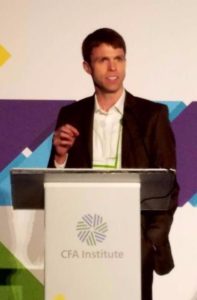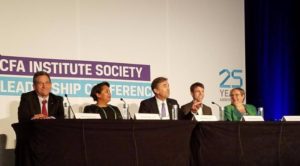By Amanda Carter, CFA and Charles Hannema
The CFA Society of Minnesota hosted a panel discussion on the topic, Inclusion in Investment Management: Beyond Checking the Diversity Box on October 4, 2017. The panel was facilitated by Kim Brustuen, CFA, SVP and National Sales Manager – Corporate Treasury, US Bank with Colin Lundgren, CFA, Global Head of Fixed Income at Columbia Threadneedle, and Paul Smith, CFA, President and CEO of the CFA Institute, as panelists.
In response to questions prompted by Bruestuen and the audience, Lundgren and Smith articulated how Columbia Threadneedle and the CFA Society defined diversity within their respective organizations, how definitions vary across different global constituents, and how having a diverse talent pool has benefited the investment management community.
Kim Brustuen referenced a McKinsey & Company white paper, Diversity Matters , in her comments and questions. The McKinsey paper cited analysis showing a statistically significant relationship between a more diverse leadership team and better financial performance. Much of the discussion centered on gender diversity and why, although strides have been made at entry level for women, there are still significant concerns about gender diversity in senior management. Paul Smith noted that female candidates outside the United States comprise a much larger percentage of candidates in the CFA Program.
The discussion, in our opinion, prompted more questions than it answered, particularly with respect to diversity that is not gender related. The evening reinforced the value of deliberate inclusion of diverse thought and background while prompting the need to expand the discussion.



Additional event photos are located on our society Facebook page https://www.facebook.com/cfaminnesota/







 iday morning I was able to participate in a debate on the future of the profession. Besides myself, the debate included Society leaders from New Zealand, France and South Africa. The moderator was from Turkey, making it a truly global panel. The exact motion we debated was “This house believes that the investment profession as we know it will be obsolete in 10 years.” I represented the opposition, arguing that the profession will not be obsolete at that time. We had a lot of fun during the debate and it was a highlight of the conference for many attendees. It definitely spurred lots of interesting conversation afterward.
iday morning I was able to participate in a debate on the future of the profession. Besides myself, the debate included Society leaders from New Zealand, France and South Africa. The moderator was from Turkey, making it a truly global panel. The exact motion we debated was “This house believes that the investment profession as we know it will be obsolete in 10 years.” I represented the opposition, arguing that the profession will not be obsolete at that time. We had a lot of fun during the debate and it was a highlight of the conference for many attendees. It definitely spurred lots of interesting conversation afterward.